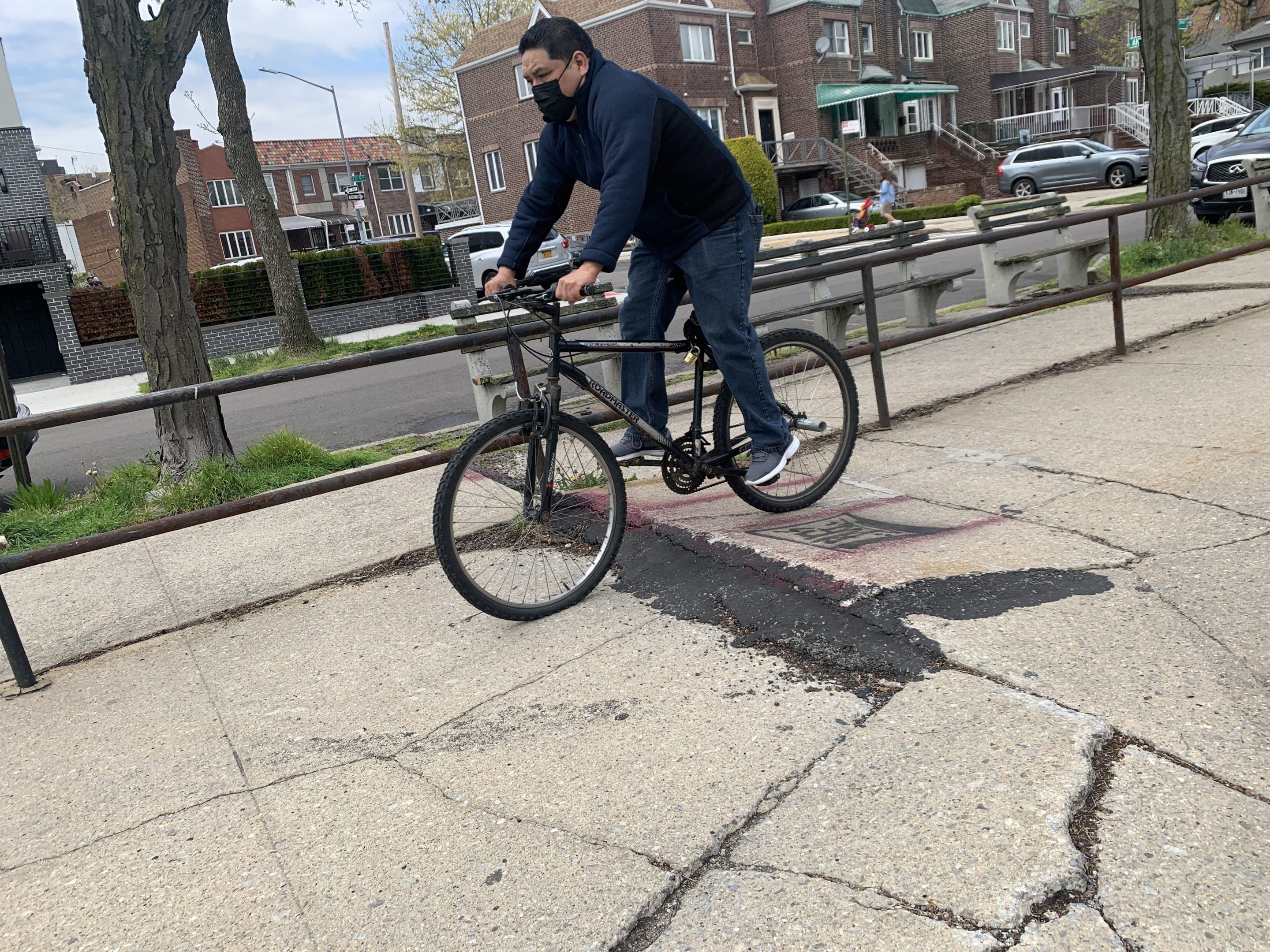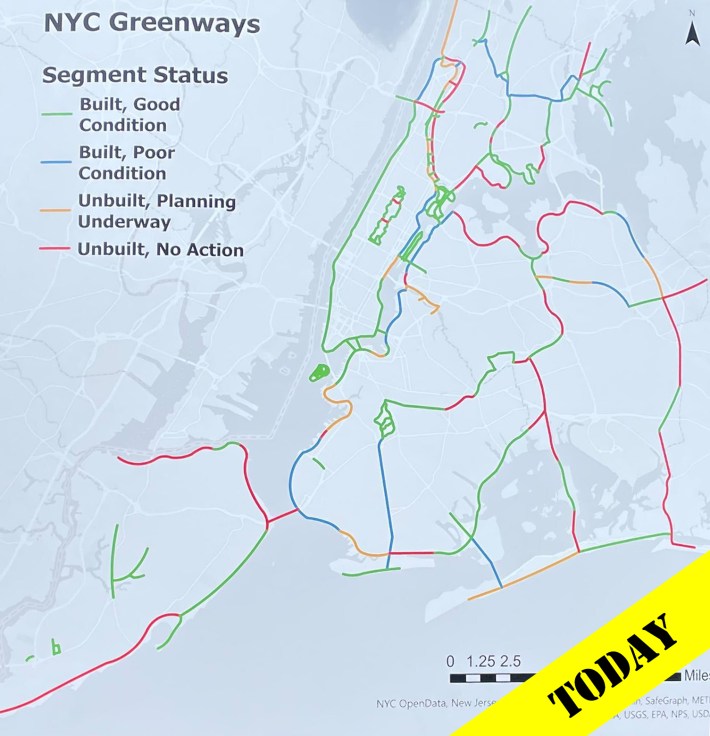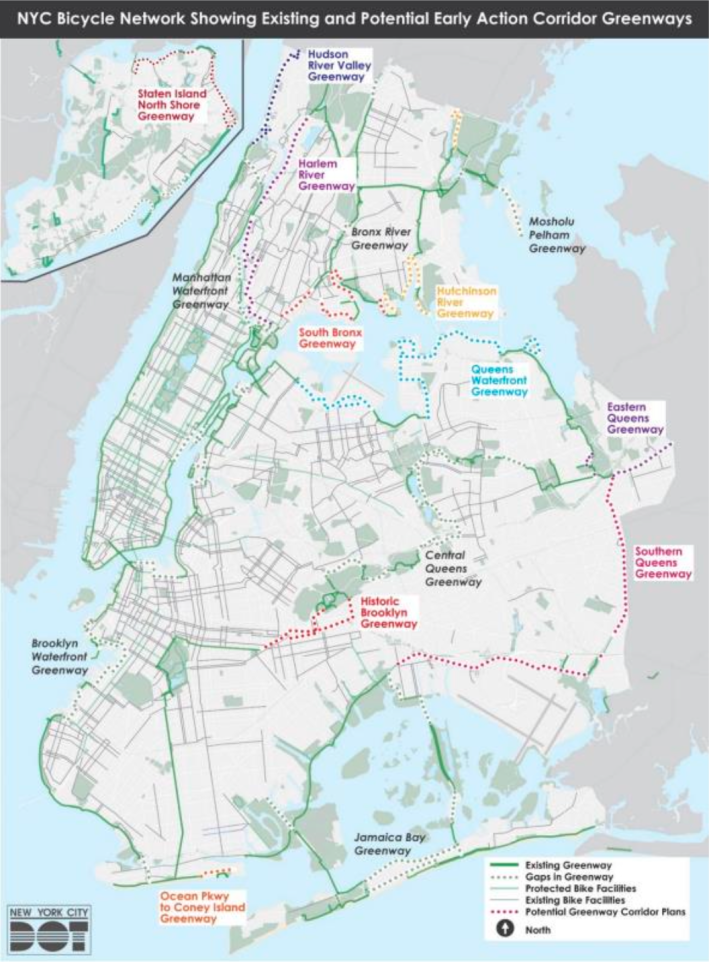What Does Schumer’s ‘Greenway Bucks’ Mean for NYC?
1:09 PM EDT on August 11, 2022

This is a greenway, according to the city. Photo: Gersh Kuntzman
Don't break out the bikes just yet.
The U.S. Department of Transportation announced on Thursday that it has awarded the city $7.25 million for "greenway expansion," but the fine print reveals that the money will be spent on "planning" the expansion of the greenway network — which as every cyclist in the city knows is not a network at all, but a collection of multiple stretches overseen by the Parks Department, which does not maintain the paths in any coherent fashion.
But here's the good news: You have to start somewhere — and $7.25 million pays for a lot of planning, said longtime advocate Jon Orcutt, a former Bloomberg administration official who now runs the Bike New York comms shop.

"This is a lot of money," he said. "Mayor Adams announced $50 million in greenway projects earlier this year, part of $200 million overall, and that all started with a $1-million planning grant. So this planning grant is foundational."
The initial funds from the mayor's "Destination Greenways" announcement will pay for only a few Parks-led projects in Brooklyn and Queens:
- new greenway segments in Leif Ericson Park
- reconstructing the existing greenway in part of Shore Road Park
- new segments in Flushing Meadows Corona Park, Kissena Corridor Park, and Kissena Park
Orcutt believes that it would take more than $1 billion to build out all the missing links in the city's greenway (still-not) network, but any construction begins with planning the exact rights-of-ways and designing the segments themselves.
"There is a lot of stuff that's been on paper for a long time, so the idea is to get a bunch of new rights-of-ways planned," Orcutt said. "We didn't see the 'Destination Greenways' idea get real until there was planning money."
It was no doubt helpful that the city's grant got a push from Sen. Chuck Schumer, the majority leader who crowed about the grant a few hours before it was official:
Big News for NYC:
— Chuck Schumer (@SenSchumer) August 10, 2022
We secured $7.25 million in funding from @USDOT to expand New York City's majestic greenway system!
I love riding my bike down the waterfront, and I am excited to bring greenways to communities that deserve them all across NYC. https://t.co/K5RHG12Czf
But what gaps will be filled first? No one is talking — though advocates believe there will be momentum for stretches in southeastern Queens, given that Mayor Adams and Council Speaker Adrienne Adams are from there (and frequently remind listeners of that).
The federal planning money comes as the City Council is still taking up a "greenways master plan" bill that requires the city to create (and then maintain) the full greenway network in the city’s original 1993 plan (hat tip, Mayor Dinkins). The bill's sponsor told Streetsblog in June that the city has done a horrible job of finishing the full network.
Agreed Conduit is low hanging fruit for greenway expansion. We’ve heard it discussed in connection with this planning effort
— Bike New York (@bikenewyork) August 10, 2022
“Many of New York’s 100 miles of greenways exist only on paper,” Council Member (and would-be Congresswoman) Carlina Rivera said. “New York City’s greenway system is currently a collection of fragments. We want to change that.”
That bill provides the mandate that requires the city to do something, Orcutt said. And the federal grant gets it started.
"I'm optimistic," he said. "We're getting a lot more attention."
To get a sense of how long it takes to build greenways in this city, take a look at the map of the gaps (right). A segment connecting Red Hook and Sunset Park along Third and Second avenues in Brooklyn dates back to 2005 and got its planning money under President George W. Bush, thanks to Rep. Nydia Velazquez, that year. It's still not done. And the body count is mounting, yet the only update on the New York City Department of Transportation's "current projects" page is a PDF from 2014 — more than eight years ago.
And that thick green line on the map along Ocean Parkway? It's a greenway on paper; on wheels, it's a root-riven, pothole-pocked mess.
The planning money came as part of the U.S. DOT's newly expanded transportation grant program called Rebuilding American Infrastructure with Sustainability and Equity grants — which will allocate roughly $2.2 billion to 166 projects across all 50 states, the District of Columbia, and Puerto Rico. Believe it or not, the pot of money that's roughly the same as how much interest on the national debt increases every six minutes is one of the largest pots of discretionary funds available for Secretary Pete Buttigieg to influence the transportation future of American communities, as Streetsblog USA reported on Thursday.
“These projects will improve our supply chains to lower the cost of goods, connect communities that are currently divided, reduce the pollution and the carbon emissions that come from our transportation systems, create jobs and foster economic opportunity, and improve safety on our roads and rails,” said Buttigieg. “Learning about these projects and providing the funding to help make for them realities is one of the best parts of serving in this role.”
As during the last RAISE grant cycle, sustainable transportation advocates praised the list for living up to the program’s name and prioritizing sustainability and equity — and not just for drivers.
“The FY22 RAISE grants underscore the urgency that all communities — rural, suburban and urban — are feeling to provide safe and connected active transportation infrastructure that gets people where they need to go whether or not they have a car,” said Kevin Mills, vice president of policy for the Rails-to-Trails Conservancy. “U.S. DOT has demonstrated its understanding that trails, walking and biking are fundamental to transformative and equitable community design that improves our quality of life.”
And when it came to projects that would add more asphalt for drivers, the DOT repeatedly emphasized the benefits to other groups, too. Once again, active transportation infrastructure was included in the majority of these competitive grant projects — officials estimated that about 70 percent — and the DOT even claimed that several lane-widening projects would benefit transit. The overhaul of 22nd Street in Tucson, for instance, would remove weight restrictions on a crucial bridge and enable buses to travel over it, shortening some bus riders’ trips by up to 30 minutes.
“Historically, RAISE has seen a significant number of projects that were [focused on] roadways,” said Christopher Coes, assistant secretary for transportation policy. “But as part of the bipartisan infrastructure law and through the work of our Federal Highway Administration, we’ve been encouraging project sponsors to think more holistically. This round, we saw an allocation [where] about 52 percent of our funding [is] going to roadways, but a very significant number of those projects included Complete Streets elements.”
Here are a few of the other notable projects:
- A $25-million planning grant to help complete a key segment on California’s high speed rail line
- A new shared use path on a retired elevated train line in Chicago. ($20M)
- Infrastructure to stop drivers, bicyclists and pedestrian crashes along Florida’s Brightline rail line ($25M)
- Funding for major bicycle/pedestrian bridges over highways, rivers and other barriers that restrict the mobility of undeserved communities, including Phoenix ($25M), Arlington, Va. ($20M), Huntsville, Ala. ($20M), Alamosa, Colo. ($5M), and Sheboygan, Wisc. ($5M)
- Critical trail and greenway extensions, new separated paths or planning in Northeast Texas ($25M), Washington, D.C. ($10M), Albuquerque, ($11M) and Winston-Salem ($6M)
- Networks of multimodal trails in small towns like Conway, Arkansas ($25M), Plainville and New Britain, Conn. ($16M), and Tulsa ($16M)
- Money for Complete Streets in Philadelphia ($25M), Detroit ($25M), Las Vegas ($24M), San Francisco ($23M), Houston ($21M), Cincinnati ($20M), Natchitoches, La. ($17M), Wheeling, W.V. ($16M), Buffalo ($25M), Pittsburgh ($11M), Boise ($5M), and many more
- Major transit facility upgrades or brand new centers in Atlanta ($25M), Lincoln ($23M), Clearwater, Fla. ($20M), the Chicago suburb of Harvey ($20M), Baton Rouge ($20M), and Prince George County, Md. ($20M)
— with Kea Wilson
Gersh Kuntzman is editor in chief of Streetsblog NYC and Streetsblog USA. He also writes the Cycle of Rage column, which is archived here.
Stay in touch
Sign up for our free newsletter
More from Streetsblog New York City
Stockholm Leader’s Message to NYC: ‘Congestion Pricing Just Works’
"In Stockholm, people really thought that congestion pricing would be the end of the world, the city will come to a standstill, no one would be able to get to work anymore and all the theaters and shops would just go bankrupt. None of that happened."
Friday’s Headlines: Trump Trial Trumps Safety Edition
Is anyone going to bother to fix the dangerous mess on the streets and plazas around the Trump trial? Plus more news.
Adams Offers Bare Minimum to Seize Congestion Pricing’s ‘Space Dividend’ Opportunity
The mayor's list of projects supposedly meant to harness congestion pricing's expected reduction in traffic is mostly old news, according to critics.
OPINION: Congestion Pricing Will Help My Family Get Around As We Navigate Cancer Treatment
My partner was recently diagnosed with cancer. Congestion pricing will make getting her to treatment faster and easier.





